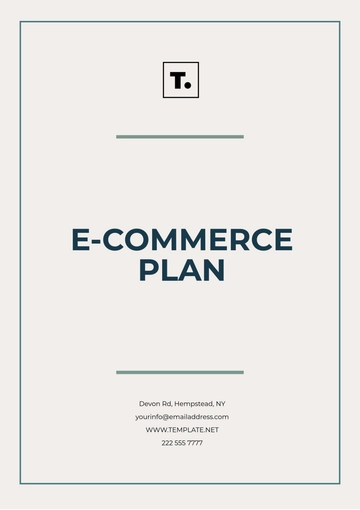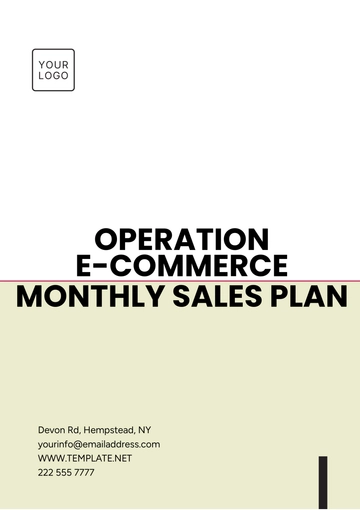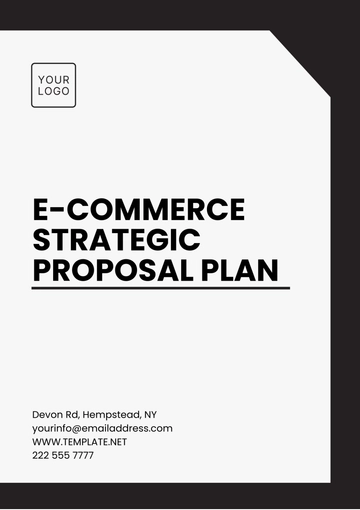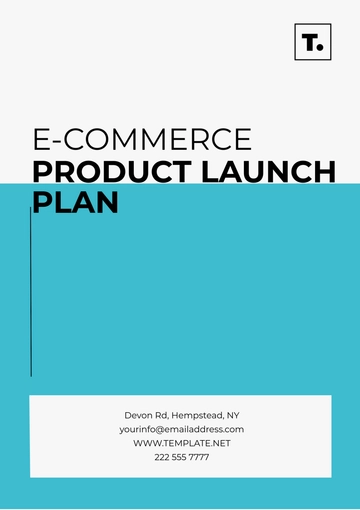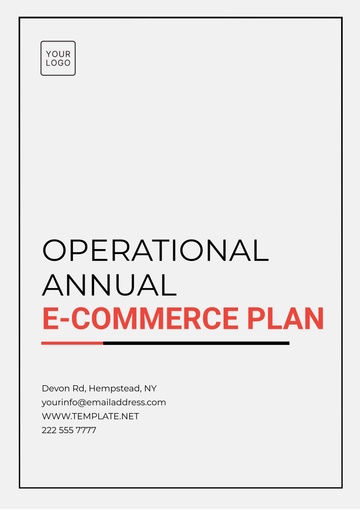Free 90 Days E-commerce Layout Plan

Prepared by: [YOUR NAME]
Organization: [YOUR COMPANY NAME]
Phase 1: Preparation (Days 1-30)
Objectives
Establish a clear vision and goals for the e-commerce business.
Develop the foundational elements of the online store.
Key Activities
Market Research and Analysis
Identify target audience and customer personas.
Analyze competitors’ strengths and weaknesses.
Explore market trends and opportunities.
Business Model Development
Define the value proposition.
Select product offerings (inventory management).
Choose an appropriate pricing strategy.
E-commerce Platform Selection
Evaluate and select an e-commerce platform (Shopify, WooCommerce, etc.).
Ensure integration capabilities with payment gateways, shipping providers, and analytics tools.
Website Design and Development
Create a user-friendly and mobile-responsive website layout.
Optimize for SEO (search engine optimization) from the start.
Set up essential pages (Home, Product, About Us, Contact, Policies).
Logistics and Supply Chain Setup
Identify suppliers and establish partnerships.
Plan inventory management and warehousing logistics.
Set shipping and fulfillment processes.
Key Performance Indicators (KPIs)
Completion of market research report.
Platform selection and website design mockup approval.
Supplier agreements and logistics plan finalized.
Phase 2: Launch (Days 31-60)
Objectives
Officially launch the e-commerce website.
Implement marketing strategies to drive traffic and sales.
Key Activities
Final Website Launch
Test website functionality (checkout, payment processing, etc.).
Launch the website publicly.
Marketing Strategy Development
Create an initial marketing campaign plan (social media, email, PPC).
Develop content for product descriptions and blog posts.
Social Media and Content Marketing
Set up social media profiles on relevant platforms.
Begin posting engaging content and promotions.
Utilize influencers for product promotion, if applicable.
Email Marketing Setup
Build an email list (signup incentives).
Design and schedule automated email campaigns (welcome series, abandoned cart recovery).
Paid Advertising Campaigns
Launch initial paid advertising campaigns (Google Ads, Facebook Ads).
Monitor ad performance and make adjustments as necessary.
Key Performance Indicators (KPIs)
Number of website visitors and unique users.
Conversion rates and total sales generated.
Growth of email list and social media engagement metrics.
Phase 3: Optimization (Days 61-90)
Objectives
Analyze performance data and optimize operations.
Enhance customer experience and retention strategies.
Key Activities
Performance Analysis
Review analytics (Google Analytics, sales data) to assess traffic sources and conversion rates.
Identify high-performing products and areas needing improvement.
Customer Feedback and Engagement
Collect customer feedback through surveys and reviews.
Respond to inquiries and engage with customers on social media.
A/B Testing
Test different website elements (product pages, call-to-action buttons) to optimize conversion rates.
Experiment with various marketing messages and ad placements.
Inventory Management and Supply Chain Review
Analyze inventory turnover rates and adjust stock levels based on sales trends.
Reassess supplier relationships and logistics for efficiency.
Loyalty and Retention Programs
Develop customer loyalty programs or incentives to encourage repeat purchases.
Implement strategies for upselling and cross-selling.
Key Performance Indicators (KPIs)
Improvement in conversion rates.
Customer retention rates and repeat purchase metrics.
Overall sales growth and profitability analysis.
Conclusion
The 90-day E-commerce Layout Plan is designed to create a structured approach for launching and optimizing an e-commerce business. By following this plan, businesses can ensure that they are strategically positioned to meet their goals and respond to market demands effectively. Regular monitoring of KPIs will allow for adjustments and enhancements throughout the process, leading to sustained growth and success in the e-commerce landscape.
- 100% Customizable, free editor
- Access 1 Million+ Templates, photo’s & graphics
- Download or share as a template
- Click and replace photos, graphics, text, backgrounds
- Resize, crop, AI write & more
- Access advanced editor
Accelerate your e-commerce success with the 90 Days E-commerce Layout Plan Template from Template.net. This fully editable and customizable template provides a strategic framework to outline your goals for the next three months. Utilize our AI Editor Tool to make real-time adjustments, ensuring your layout aligns with your business vision. Start your journey today!
You may also like
- Finance Plan
- Construction Plan
- Sales Plan
- Development Plan
- Career Plan
- Budget Plan
- HR Plan
- Education Plan
- Transition Plan
- Work Plan
- Training Plan
- Communication Plan
- Operation Plan
- Health And Safety Plan
- Strategy Plan
- Professional Development Plan
- Advertising Plan
- Risk Management Plan
- Restaurant Plan
- School Plan
- Nursing Home Patient Care Plan
- Nursing Care Plan
- Plan Event
- Startup Plan
- Social Media Plan
- Staffing Plan
- Annual Plan
- Content Plan
- Payment Plan
- Implementation Plan
- Hotel Plan
- Workout Plan
- Accounting Plan
- Campaign Plan
- Essay Plan
- 30 60 90 Day Plan
- Research Plan
- Recruitment Plan
- 90 Day Plan
- Quarterly Plan
- Emergency Plan
- 5 Year Plan
- Gym Plan
- Personal Plan
- IT and Software Plan
- Treatment Plan
- Real Estate Plan
- Law Firm Plan
- Healthcare Plan
- Improvement Plan
- Media Plan
- 5 Year Business Plan
- Learning Plan
- Marketing Campaign Plan
- Travel Agency Plan
- Cleaning Services Plan
- Interior Design Plan
- Performance Plan
- PR Plan
- Birth Plan
- Life Plan
- SEO Plan
- Disaster Recovery Plan
- Continuity Plan
- Launch Plan
- Legal Plan
- Behavior Plan
- Performance Improvement Plan
- Salon Plan
- Security Plan
- Security Management Plan
- Employee Development Plan
- Quality Plan
- Service Improvement Plan
- Growth Plan
- Incident Response Plan
- Basketball Plan
- Emergency Action Plan
- Product Launch Plan
- Spa Plan
- Employee Training Plan
- Data Analysis Plan
- Employee Action Plan
- Territory Plan
- Audit Plan
- Classroom Plan
- Activity Plan
- Parenting Plan
- Care Plan
- Project Execution Plan
- Exercise Plan
- Internship Plan
- Software Development Plan
- Continuous Improvement Plan
- Leave Plan
- 90 Day Sales Plan
- Advertising Agency Plan
- Employee Transition Plan
- Smart Action Plan
- Workplace Safety Plan
- Behavior Change Plan
- Contingency Plan
- Continuity of Operations Plan
- Health Plan
- Quality Control Plan
- Self Plan
- Sports Development Plan
- Change Management Plan
- Ecommerce Plan
- Personal Financial Plan
- Process Improvement Plan
- 30-60-90 Day Sales Plan
- Crisis Management Plan
- Engagement Plan
- Execution Plan
- Pandemic Plan
- Quality Assurance Plan
- Service Continuity Plan
- Agile Project Plan
- Fundraising Plan
- Job Transition Plan
- Asset Maintenance Plan
- Maintenance Plan
- Software Test Plan
- Staff Training and Development Plan
- 3 Year Plan
- Brand Activation Plan
- Release Plan
- Resource Plan
- Risk Mitigation Plan
- Teacher Plan
- 30 60 90 Day Plan for New Manager
- Food Safety Plan
- Food Truck Plan
- Hiring Plan
- Quality Management Plan
- Wellness Plan
- Behavior Intervention Plan
- Bonus Plan
- Investment Plan
- Maternity Leave Plan
- Pandemic Response Plan
- Succession Planning
- Coaching Plan
- Configuration Management Plan
- Remote Work Plan
- Self Care Plan
- Teaching Plan
- 100-Day Plan
- HACCP Plan
- Student Plan
- Sustainability Plan
- 30 60 90 Day Plan for Interview
- Access Plan
- Site Specific Safety Plan
